The Temple of Heaven, situated in the Dongcheng District of Beijing, is the largest and best-preserved altar complex in China, even in the world. It used to be a vital place for emperors during the Ming and Qing Dynasties (1368-1911) to perform national sacrificial ceremonies. With its profound cultural connotation and magnificent architectural style, the complex has become a portrayal of ancient oriental civilization and a famous tourist attraction in Beijing, crowded with visitors from home and abroad.
What is the Temple of Heaven?
- It is the largest existing ancient sacrificial complex in the world.
- It was listed as a World Cultural Heritage site in 1998 by UNESCO.
- It is the best example of ancient Chinese architecture of the Ming and Qing Dynasties (1368-1911). And the overall layout and the design of buildings express the understanding of ancient Chinese people toward nature that the Heaven was round and the Earth was square.
Basic Facts about the Temple of Heaven:
- Where is the Temple of Heaven?
It is located at No. 7 of Tiantan Inner East Road in Dongcheng District of Beijing, about 4 kilometers south of Tian’anmen Square and the Forbidden City, which are seated in the very center of the city of Beijing.
- When was the Temple of Heaven built? Who built the Temple of Heaven?
The temple was founded in 1420 under the order of Emperor Yongle of the Ming Dynasty (1368-1644) and reached the present scale during the period of Emperor Qianlong of the Qing Dynasty, who reigned from 1736 to 1796.
- How big is the Temple of Heaven?
The whole complex covers an area of 2,730,000 square meters, which is four times the size of the Forbidden City.
- Why was the Temple of Heaven built?
It was originally built as a place for emperors to hold national worship ceremonies to offer sacrifices to Heaven and pray for fair weather and a good harvest.
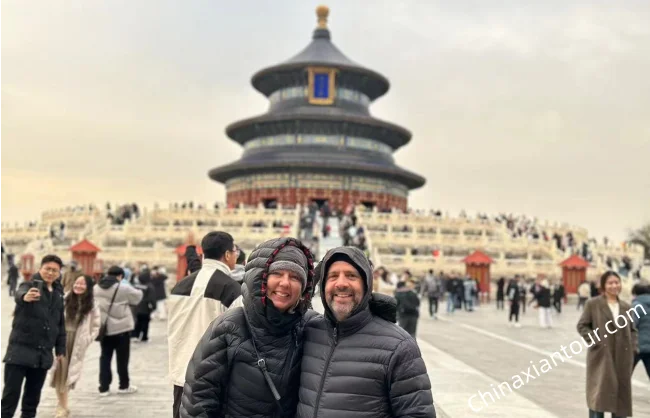
History of the Temple of Heaven in Beijing (Major Events)
- The Emperor Yongle moved the capital from Nanjing to Beijing City in 1420. The same year, he ordered the construction of this altar complex and practiced the first sacrificial ceremony the next year there to worship both the Heaven and the Earth.
- In 1530, Emperor Jiajing of the Ming Dynasty decided to worship the Heaven and the Earth separately, and named the existing altar the Temple of Heaven and built another one –the Temple of Earth – in the north of Beijing Ci
- When Emperor Qianlong of the Qing Dynasty came to power, the complex underwent an extensive restoration. He ordered to replace the roofs of main halls with cyan glazed-tiles, expand the Circular Mound Altar, reinforce the outer walls with bricks, plant more cypresses…A series of actions formed the temple to its present structure.
- The Temple of Heaven was officially open for public visiting on January 1st, 1918.
Why is the Temple of Heaven in China Important?
The temple is one of the ancient Chinese architectures with the greatest artistic and ideological significance. It was the place where emperors of the Ming and Qing dynasties performed grand ceremonies to worship Heaven and pray for the fortune of the state. Therefore, it best conveys traditional Chinese philosophical concepts toward nature, which have been passed on in China for over 5,000 years, making the complex one cultural symbol of the country.
Sacrificial Ceremonies in the Temple of Heaven
1. When Was the Sacrificial Ceremony Held?
Worshipping the Heaven was the greatest and most solemn sacrificial ritual in ancient China, which had been practiced for thousands of years. During the Ming and Qing dynasties, emperors held the grand worshipping ceremony at the Temple of Heaven every winter solstice, which was considered the beginning of a new circulation according to Chinese culture.
2. Preparation Work for the Ceremony
There was a complete restoration of buildings inside the Temple of Heaven Beijing before the ritual. Besides, princes were sent to the altar five days ahead of the time to supervise the preparation of sacrificial offerings. There was a three-day fast for the emperors, during which they prepared for their speech on the ceremony. Emperors would move to the Fasting Palace in the temple the day before the ceremony and all the sacrificial offerings and utensils should be all set at the same time.
3. What Did Emperors Do on the Sacrificial Ceremony?
The ceremony officially started at around 04:00 in the morning. Considered the son of Heaven, emperors, who dressed in the dragon robe and wore the crown, would offer sacrifices to the gods on behalf of the common people to pray for a prosperous year for the state. Then, they would make a speech to express their awe and gratitude toward Heaven. Emperors’ burning incense and worshipping was the last link of the whole procedure, and all the sacrificial offerings would be burnt when the ceremony ended.
The Grand and Mystical Architectures of the Temple of Heaven Beijing
Two sets of walls divide the Tempe of Heaven into two parts, the Inner Temple and the Outer Temple. The Outer Temple is a large area of garden landscape with a lot of century-old cypresses, while major ancient buildings are concentrated in the Inner Temple, with the Hall of Prayer for Good Harvests, Imperial Vault of Heaven and Circular Mound Altar being the most characteristic structures.
1. The Hall of Prayer for Good Harvests
The Hall of Prayer for Good Harvests, seated in the center of a three-layer marble altar, is the largest and finest architecture of the Temple of Heaven, and also one of the symbolic sites of Beijing. It was in this hall that emperors performed grand worshipping ceremonies to pray for good crop yields for the state.
In ancient times, Chinese people believed the Heaven was round and the Earth was square. Therefore, the Hall of Prayer for Good Harvests was designed round with three layers of cyan-colored eaves to symbolize the Heaven. Inside the palace, visitors will appreciate a variety of exquisite colored paintings, as well as 28 huge columns representing the 4 seasons, 12 months and 12 two-hour periods which are named of the 12 Earthly Branches.
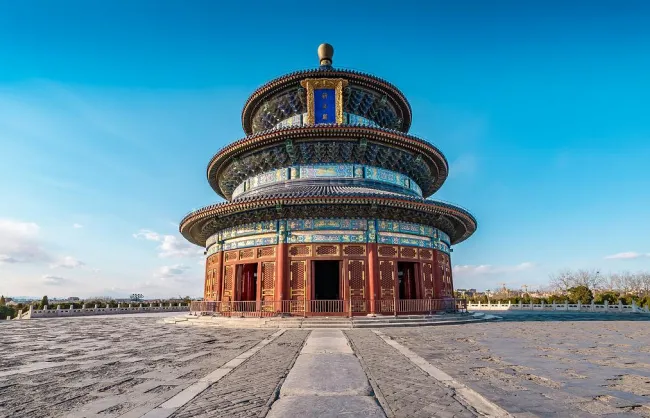
2. The Imperial Vault of Heaven & Echo Wall
Follow the 360-meter-long and 30-meter-wide Danbi Bridge to the south and you will reach at the Imperial Vault of Heaven. It is a small structure built in 1530 to enshrine memorial tablets of gods at ordinary times.
Encircling the hall is the famous Echo Wall. It is 3.72 meters high, 61.5 meters in diameter and 193 meters of the whole circumference. As its name indicates, you can hear your echo clearly if you speak or clap hands at any position near the wall. Even people whisper at one end of the wall, their voices could be heard at the other end.
3. Circular Mound Altar
The Circular Mound Altar is another highlight of architecture in the Temple of Heaven. It is a three-layer marble altar founded in 1530 and expanded in 1749. It was used for holding worshipping ceremony for Heaven on winter solstice. The design of the Circular Mound Altar is also a perfect show of ancient Chinese philosophy, as the number of the steps, railings and flagstones are all multiples of 9 which stands for longevity, eternity, and supreme power in Chinese culture.
Beijing Day Tours including the Temple of Heaven:
Today’s Temple of Heaven – the Back Garden for Beijingers
For visitors, the Temple of Heaven in Beijing is a historical site with a profound cultural atmosphere and magnificent architecture. But in local people’s minds, this complex, especially the area of the Outer Temple, is more like a tranquil garden for them to hang out. The early morning is the most vibrant time of the day when a lot of locals gather to do exercises. You might want to join them to dance, kick the shuttlecock, learn some Tai Chi moves… It will definitely be the best chance to immerse in the local lifestyle and could make for a special experience for your China tours.
How to Buy Temple of Heaven Entrance Tickets:
- Price of Entrance Tickets:
The ticket price of the Temple of Heaven is different in peak season (Apr. 1st to Oct. 31st) and low season (Nov. 1st to Mar. 31st), and there is a through ticket including the entrance ticket, the Hall of Prayer for Good Harvests, the Echo Wall and the Circular Mound Altar.
| Peak Season | Admission Fee: CNY 15; Through Ticket: CNY 34 |
| Low Season | Admission Fee: CNY 10; Through Ticket: CNY 28 |
| The Divine Music Administration | Admission Fee: CNY 10 |
| Combo Ticket of Scenic Spots:
(Hall of Prayer for Good Harvests, Echo Wall, and Circular Mound Altar.) |
CNY 20 |
- Opening Time:
| Entrance Gate | Peak Season: 06:00 – 22:00 | Ticketing Time | Entrance Ticket: 06:00 – 21:00 |
| Combo Ticket: 08:00 – 16:00 | |||
| Low Season: 06:30 – 22:00 | Ticketing Time | Entrance Ticket: 06:30 – 21:00 | |
| Combo Ticket: 08:00 – 15:30 | |||
| Scenic Spots inside, including the Hall of Prayer for Good Harvests, the Echo Wall, the Circular Mound Altar, the Fasting Palace, the Divine Kitchen (North), the Animal Sacrifice Pavilion (North) | Peak Season: 08:00 – 18:00
Ticketing Time: 08:00 – 17:30 |
||
| Low Season: 08:00 – 17:00
Ticketing Time: 08:00 – 16:30 |
|||
Note: Scenic spots inside the Temple of Heaven are open from Tuesday to Sunday throughout the year, and closed on Mondays, except national holidays.
When is the Best Time for the Temple of Heaven Tour?
The Temple of Heaven in Beijing is actually suitable to visit all year round as plants inside remain green throughout the year, creating a beautiful environment. However, spring (March-May) and autumn (September-November) are widely considered the best time to tour the Temple of Heaven, when the weather is pleasant and cozy for a Beijing tour.
The scenery of the Outer Temple in the spring is the most captivating of the year. At the beginning of April, the apricot trees left from the Qing Dynasty blossom all over the garden. There are also abundant lilacs on the west side of the Hall of Prayer for Good Harvests, which covers an area of about 6,000 square meters with more than 200 trees.
How to Tour the Temple of Heaven?
There are eight sightseeing routes as follows, depending on your visiting length. Each route is displayed on the touring map of the Temple of Heaven below and you may choose one that suits you best.
The Tour Routes of Half an Hour
Option 1: North Gate → the Hall of Prayer for Good Harvests → North Gate

Option 2: South Gate → the Circular Mound Altar → the Echo Wall → South Gate
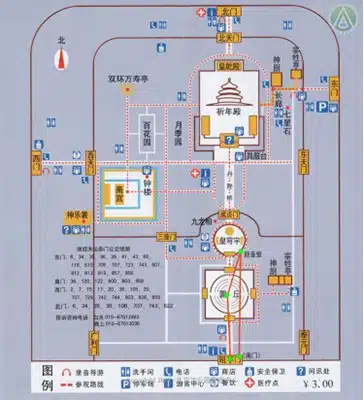
The Tour Routes of an Hour
Option 1: South Gate → the Circular Mound Altar → the Echo Wall → the Nine-Dragon Cypress → Danbi Bridge → the Hall of Prayer for Good Harvests → North Gate
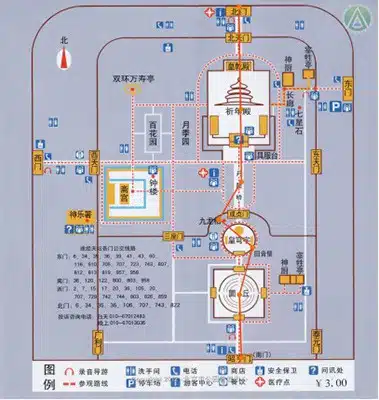
Option 2: North Gate → the Hall of Prayer for Good Harvests → Danbi Bridge → the Nine-Dragon Cypress → the Echo Wall → the Circular Mound Altar → South Gate
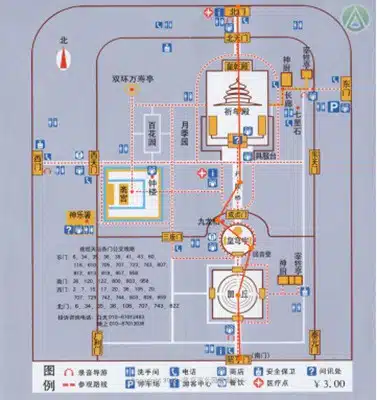
Option 3: East Gate → the Long Corridor → the Hall of Prayer for Good Harvests → Danbi Bridge → the Echo Wall → the Circular Mound Altar → South Gate
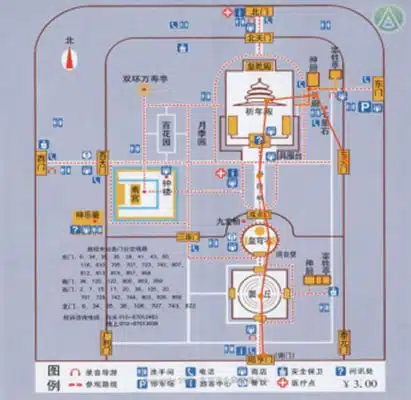
Option 4: West Gate → the Fasting Palace → the Divine Music Administration → West Gate

The Tour Routes of Two Hours
Option 1: South Gate → the Circular Mound Altar → the Echo Wall → the Nine-Dragon Cypress → Danbi Bridge → the Hall of Prayer for Good Harvests → the Divine Music Administration → the Fasting Palace → West Gate
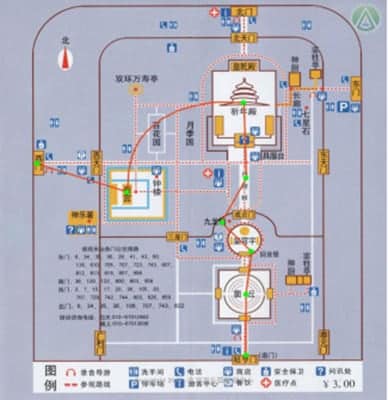
Option 2: North Gate → the Hall of Prayer for Good Harvests → Danbi Bridge → the Nine-Dragon Cypress → the Echo Wall → the Divine Music Administration →the Fasting Palace → West Gate

How to Get to the Temple of Heaven?
By Bus
- To the Eastern Gate:
Visitors can take bus line 6, 17, 34, 35, 36, 39, 41, 43, 60, 72, 84, 116, 128, 599, Night Bus No. 11, and Night Bus No. 24, get off at Fahuasi Station and walk southward for 150 meters to the temple.
- To the Western Gate:
Visitors can take bus line 2, 7, 20, 36, 53, 71, 72, 90, 93, 120, 141, 622, Zhuan-153, BRT Line 1, Night Bus No. 2, Night Bus No. 17, and Tongyou Tourist Bus Line 16 to Tiantan Ximen Station. You will see the Temple of Heaven the moment you get off the bus.
- To the Southern Gate:
Bus lines 36, 53, 62, 122, 141, 200, 958, Zhuan-202, Night Bus No. 20, and Tongyou Tourist Bus Line 16 are available for visitors. Mind to get off at Tiantan Nanmen Station and walk for around 150 meters to the temple.
- To the Northern Gate:
It is available for tourists to take bus line 6, 34, 35, 36, 72, 106, 110, and Night Bus No. 11, get off at Tiantan Beimen Station and walk eastward for 100 meters to the temple.
By Subway
- It is convenient for tourists to take Subway Line 5 and get off at Tiantan DongmenStation. Leave from Exit A2 which is next to the eastern gate of the temple.
- Visitors can also take Subway Line 8 to Tianqiao Station, get out from Exit C and you will reach at the western gate of the temple.









